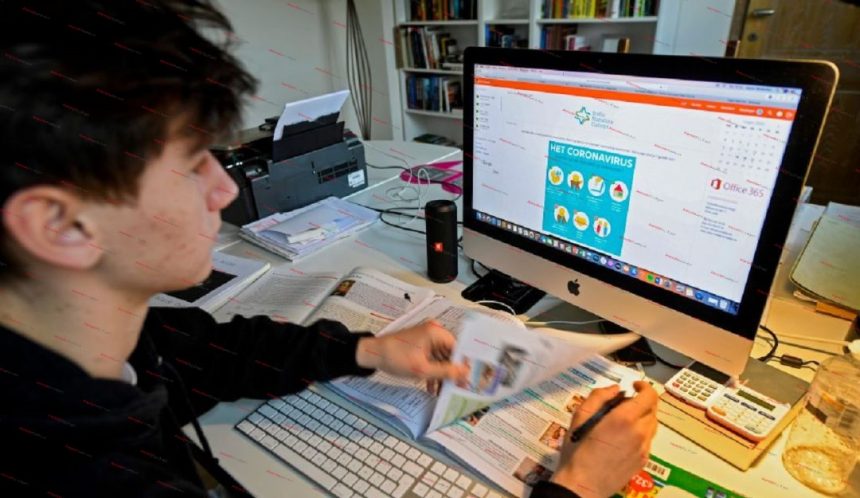Illustrative Photo, W Radio
More than 40 million people participate at all levels of the education system in Mexico. That includes teachers, administrative personnel, and students. On August 24—and with families at home—they will team up with digital television and radio to broadcast classes remotely. Secretary of Public Education Esteban Moctezuma made the announcement on August 3. However, there are still doubts about how remote classrooms will work, what the learning channels will be, and at what time the 30 million students should be in front of the television or radio—accompanied by tutor, textbooks, and workbooks. However, enabling students to learn at home will decrease the potential for contagion and allow the economy to be reactivated sooner, according to Moctezuma. And because of the country’s controversial 2015 program, Mover a Mexico (Moving Mexico), it will be possible to reach 30 million students through six open television channels and 36 radio stations—24 hours a day, seven days a week.
The program was highly criticized for being politically motivated when it started, and it was later canceled. It nevertheless managed to distribute 14 million digital TV sets to as many families, with an investment of 19 million pesos. Those who received the sets qualified, according to the national Social Development Office, as households with limited resources. The need for new TV sets came about because the government switched from analog to digital open TV signals at the end of 2015. The sets given out had 24-inch screens and the capacity for an Internet connection.
Fifteen million emails
In June, the Department of Public Education (SEP) said that until each state gets the “green light” status for COVID-19, local authorities will determine the process for returning to in-person classrooms. At that time, health protocols must be followed. Moctezuma explained that the new model “does not replace the school; teachers are irreplaceable.” Still, it is thanks to technology that it was possible to conclude the 2019–2020 school year. One million public education teachers were trained in the use of digital tools, and 15 million students “had, for the first time, an email address,” which allowed them to work with the new education system’s new technologies.
“Distance education has a solid and equitable base. The books will be in the states on time, thanks to the teachers, the armed forces, and parents. Students will follow the plans and study programs and will have access to the requisite classes,” said Moctezuma. He also explained that 4,550 television programs and 640 radio programs will be produced. They will be transmitted in 20 indigenous languages, from the earliest grades through high school, and “all will have sign language. The books will also be printed in Braille and large print.”
Parents, guardians, and students with questions may contact the SEP through their social networks and phones at 800 288 6688, 800 734 7376, and buzon.escolar@nube.sep.gob.mx.
In addition, until August 23, questions will be addressed on Channels 11 and 14 of open TV.
Channel 4, out of play
San Miguel de Allende’s cultural channel, XHSMA, is broadcast on Channel 4, whose frequency is transmitted on Channel 8 or 23 of open TV. Channel 4 will be 20 years old in September. “The effort we have made is already 20 years old. We make television to reinforce the identity and roots of San Miguel,” said Channel 4 Director Lucy Núñez.
When asked if this television station will participate in distance education, she commented, “Unfortunately, we are invisible in the eyes of the government. Our station is small; it covers the municipality. They don’t take us into account; they didn’t contact us. They gave us permission to continue operating, but since, in theory, we are a cultural channel covering San Miguel, the effort we make seems small to them. We are broadcast to Comonfort and Dolores Hidalgo via cable, compared to the millions of large channels. It is incredible that once again, the big four will get the money from the airtime that the federation will pay. It is the way the government has always thought. We don’t expect anything in return; we do it because of our love for San Miguel.” The director clarified that since Channel 4 is a digital channel, it has the infrastructure—including satellites—and the ability to transmit the educational programs that the SEP will broadcast through Televisa, Imagen, MVS, and Televisión Azteca.
In the case of radio station Radio San Miguel XESQ, which transmits using the 103.3 FM and 1280 AM frequencies, she mentioned that it will not be used either. It is true that XESQ broadcasts using AM frequency and is free, she noted; however, there are no federal government instructions on using it for the benefit of distance education. “AM has already disappeared. The government suppressed all AM signals in the country and left the band free. It is not good quality. When changing to FM, the sound is digital; it has better quality. But the government forgets that not everything is Mexico City—that there are small populations that, due to their mountainous terrain and geographical location, will have a problem because how can the signal be received where it does not reach?” Núñez wondered.
Additional questions
The education delegate for the North Region of the State of Guanajuato—Monserrat Bataller—answered some questions for Atención.

